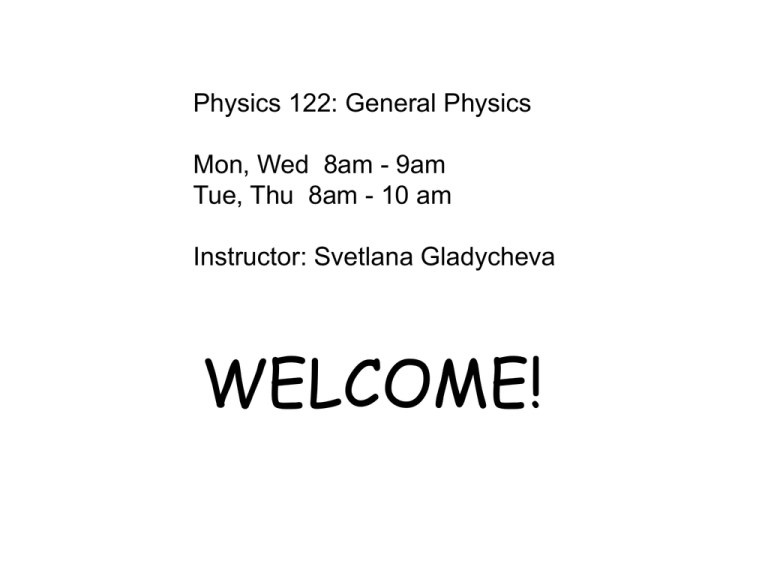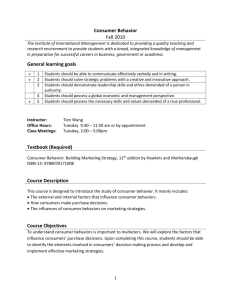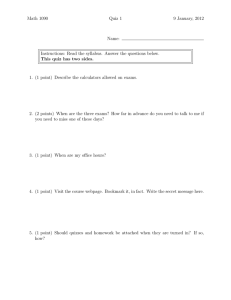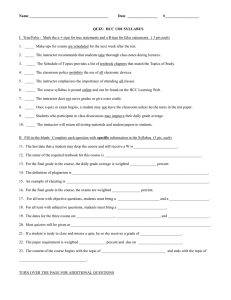WELCOME! Physics 122: General Physics Mon, Wed 8am - 9am
advertisement

Physics 122: General Physics Mon, Wed 8am - 9am Tue, Thu 8am - 10 am Instructor: Svetlana Gladycheva WELCOME! GENERAL PHYSICS PHY 102: Fall 2008 Mon, Wed: 8-9am & Tue, Thu 8-10am Room XXX INSTRUCTOR: SVETLANA GLADYCHEVA OFFICE: IB 2426C PHONE: 206-551-9925 EMAIL: sgladycheva@sccd.ctc.edu WebSite: http://faculty.northseattle.edu/sgladycheva/physics122/physics122.htm OFFICE HOURS: by appointment. COURSE DESCRIPTION: This course is the second of three algebra-based general physics series. It will introduce the foundational concepts important in many fields related to physical science. The course will focus on the study of the physics of electricity and magnetism, heat and temperature, and the physical properties of solids, liquids and gasses. There is a lab included. COURSE PHILOSOPHY: This course is designed so that through the practice of physics, students will learn to apply reasoning skills to successfully deal with new situations or tasks. The fundamental reasoning and analysis skills learned in this course should be able to be applied toward understanding practical studies in other fields of interest. Course Outcomes/Learning Objectives: Upon successful completion of the course, students will be able to: Understand and correctly handle quantities that are vectors. Analyze systems involving fluids. Analyze simple thermodynamic systems in terms of heat and temperature. Analyze systems of static charges and simple DC circuits. Apply concepts involving the interaction of charges and magnetic fields to explain the function of simple devices such as motors and generators. Lab Outcomes: Develop a testable experimental question and/or hypothesis given the relevant information. Set up an appropriate experiment given a testable experimental question or hypothesis. Analyze the results of an experiment and to draw appropriate conclusions from the results. Present the results and conclusions of an experiment following appropriate guidelines REQUIRED TEXTBOOK: Essentials of College Physics, by Serway and Vuille, Thomson Learning, Inc, 2007. OTHER MATERIALS: Scientific Calculator (any brand, graphing NOT required) Ruler with METRIC scale (any size, 12 recommended) Protractor (any size, full or half circle) Graph paper (quad. ruled paper with 5x5 divisions, engineer pad) Colored pencils Bound Lab Notebook with grid paper PREREQUISITES: PHY 101. This means that you remember this material. So if it has been many years since you took this course or if you did not do well, you may not be prepared. TIME: Academic lab courses of 5 credits generally require a minimum of 12 hours study outside of class each week. Students requiring tutoring or who are weak in prerequisite material should expect to spend additional time. CLASS MEETINGS: If you are to learn physics, you must be an active participant. Physics is something you do, not just something you watch. Attendance/participation points may not be given for students who leave early, are tardy, or miss parts of the class. The student is responsible for all material and announcements covered in class. The instructor will cover material that is not in the textbook. For this reason, students that miss class time may miss important information. It is also expected that students will be in attendance on exam days. Arrange your schedules to make this possible. COURSE WORK: Note: If you cannot be in class to turn in your work, you may email the work to me by 10:00 AM on the due date. Homework: You will receive homework every Wednesday and it will be due on the Wednesday next week. I WILL NOT ACCEPT LATE HOMEWORKS. Work that is not done according to the directions may not be accepted. Be sure to read the directions. For example, graphs will only be accepted on graph paper. All work is expected be neat, orderly, complete, and grammatically correct. Approximately 25% of each major exam will cover assigned homework problems. Labs: Please see the Lab Report handouts. Graphs will need to be done by hand unless you receive permission from the instructor to use the computer. You are expected to be in class the day that the lab is done in order to receive lab credit. If you miss the lab, you can NOT make it up. This course is a designated lab course, therefore students not demonstrating competency in laboratory outcomes will not pass the course. Approximately 25% of each major exam will cover laboratory work. Exams: There will two midterm exams and a comprehensive final. One of the midterm exams will be an oral exam (more information to follow). Make-up exams are by arrangement with the instructor for emergencies only. GRADING: Grades will be based on the percentage of points earned. Use the following as an approximate weighting for the different types of work: Exams: 2 midterm exams @ 80 points each, Final is 100 pts Homework Problem sets: 20 pts each Labs: Attendance & Lab Notebook: 5 pts Lab Reports: 25 points Warning! Students must earn 60% of lab/activity points, and turn in at least one acceptable (15 point min.) formal lab-report in order to pass the course. Students not in attendance may not get complete points. GRADE 3.9-4.0 3.5-3.8 3.2-3.4 2.9-3.1 2.5-2.8 2.2-2.4 1.9-2.1 1.5-1.8 1.2-1.4 0.9-1.1 0.7-0.8 0.0 MIN 92-100% 88-91 84-87 82-84 78-81 75-77 72-74 68-71 64-67 62-64 60-61 <60 Other Policies: Extra Credit: You are expected to know the material of this course. Don't expect extra credit, and don't ask for it. If there is any, be happy and take advantage. Know the Syllabus: You are expected to read and know the syllabus. Do not expect other students to know the policies. They are often wrong! Look it up yourself. If it says that I don't give make-ups, then don't ask. Special Circumstances: These do not include: "I just don't know the material yet." "I need more time." "I missed your announcement." "I forgot we were having a test." "I have another class, responsibility, meeting, to go to work, etc." Cell Phones: Please turn them off in class so they do not distract others in the classroom. Cell Phones will be required to be off during exams. Student Conduct: Students are expected to comply with student conduct policy and procedures. These can be found in the student handbook. Campus Resources: The LOFT (for writing help) and MLC (for math, physics, chemistry and computer help) are available for your benefit. See the quarterly bookmark for hours and services. If you need course adaptations or accommodation, Disability Services is one campus to assist you in setting this up. Plagiarism: Any incidence of plagiarizing will result in a zero grade for the assignment. Plagiarism is defined as using work from another individual as if it was your own. In this course, plagiarism will include turning in copies of any part of another person’s work as if it is your own. If this occurs, I will give both copies a zero grade. So, be careful in your sharing of work. Do not give your work to someone else. If you do use a quote or idea from someone else, you must note it using a standard format (see a style source for help). I will accept any format as long as you are consistent. For those of you who need help with this, you can find help in the LOFT. Homework: Please DO work together. This means that you should be talking to each other to figure out how to solve the problems. However, when it comes to writing it down, you write it your way. You compose the sentences and you write the equations. For graphs, you plot them yourself. Lab Reports: You are expected to do the lab with other students. That means that you will have the same data as the rest of your lab group. However, all writing in a lab report must be your own creation. This includes making the tables, graphing the data, drawing the pictures, and even writing the procedure. You may talk to others about the report but you, individually, must create everything that you turn in. Other Written Work: Again, you are expected to do the writing yourself. If you use any other person’s ideas, you must give them credit. In general, it is expected that you are demonstrating your skills and abilities, not someone else’s. Changes may be made to this course syllabus at any time. Any changes will be announced, at which point it becomes the responsibility of the student to keep track of the change. Plan for today: States of matter ---> liquids Density Pressure Variation of pressure with depth STATES OF MATTER SOLID: - Groups of atoms that maintain both shape and volume. - Bonding is strong and directional. - Crystalline or amorphous -Response to applied force -Elasticity crystalline silica silica glass LIQUID: - A collection of atoms that has no fixed shape, but is able to maintain its volume. - Usually made of molecules with weak intermolecular forces (polar) that hold them together. -These weak forces are the source of surface tension: the force that separates a liquid from the air. www.phys.ksu.edu/.../ JRML-web-training.htm GAS: - Any collection of atoms that is able to expand to take the shape and fill the volume of its container. - Made up of inert atoms or molecules that are neutral and do not bond with their neighbors but bounce off them PLASMA: - At extreme temperatures, the energy is so high that the electrons do not remain attached to the atoms, and so charged nuclei are in a sea of electrons. -Behaves a little like a gas, but, because of the free electrons, they can be confined inside of a strong magnetic field. 99.9% of the mass of the universe is in this state. What determines the state of a given matter? 1 kg Material Ice Aluminum Iron Copper Silver Lead Gold Platinum Density (kg/m3) 0.917 x 103 2.7 x 103 7.86 x 103 8.92 x 103 10.5 x 103 11.3 x 103 19.3 x 103 21.4 x 103 Water Glycerin Ethyl alcohol Benzene Mercury 1.00 x 103 1.26 x 103 0.806 x 103 0.879 x 103 13.6 x 103 Air Oxygen Hydrogen Helium 1.29 1.43 8.99 x 10-2 1.79 x 10-1 Standard atmospheric conditions: T = 0oC, P = 1 atm (105 Pa) READING ASSIGNMENT (read this material today!!!) CHAPTER 9: 9.1, 9.3, 9.4, 9.5(review), 9.6




